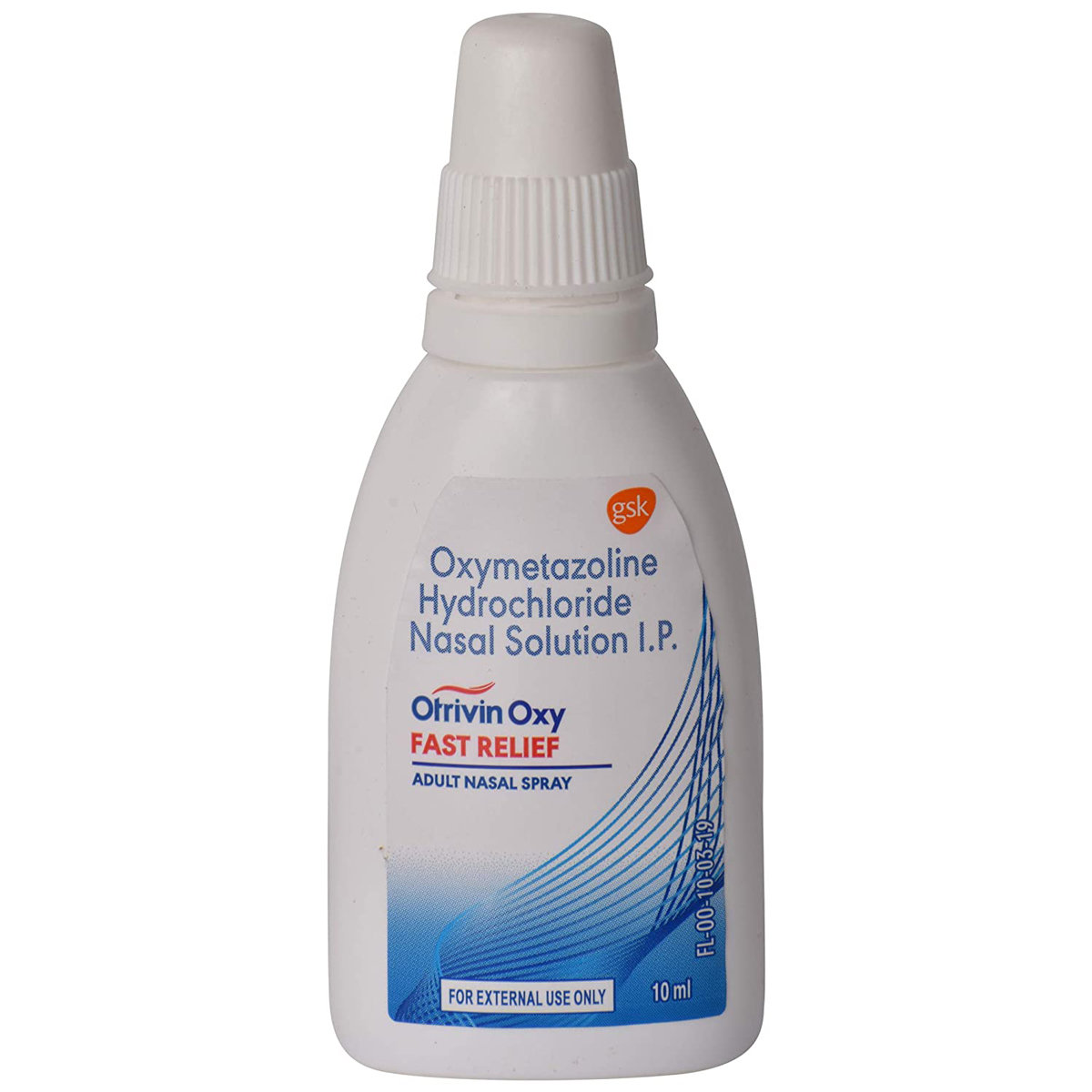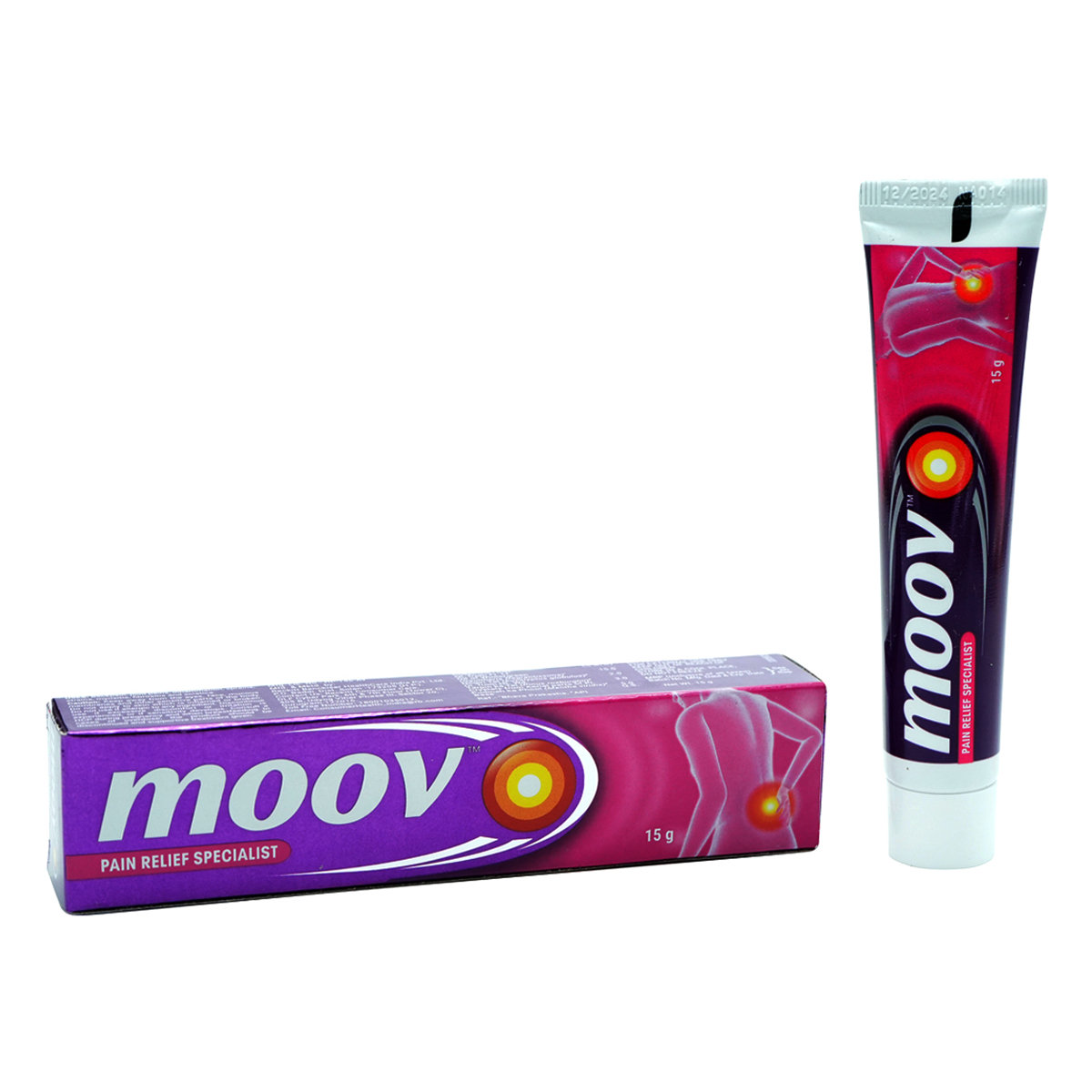Ciplox-D Eye/Ear Drops
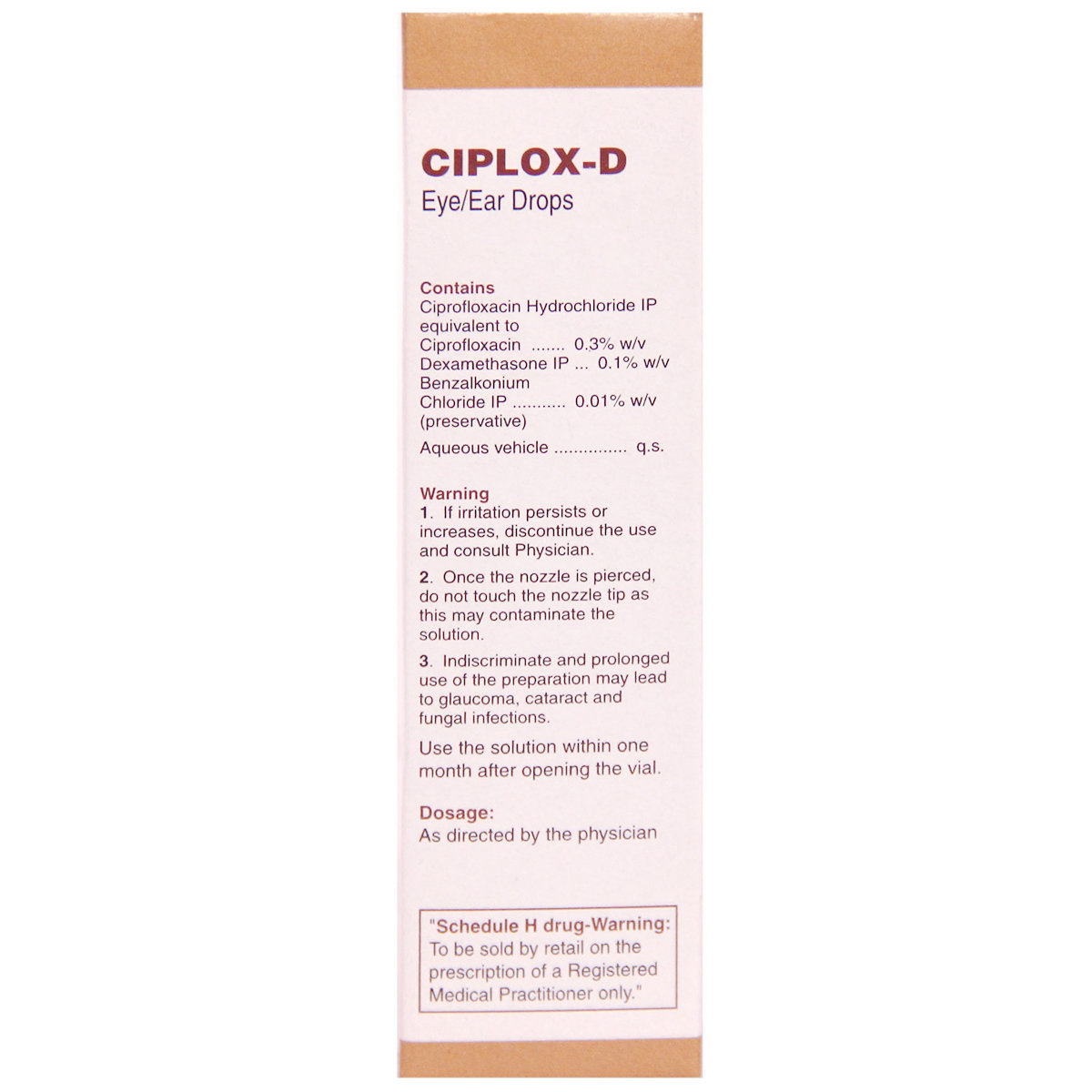

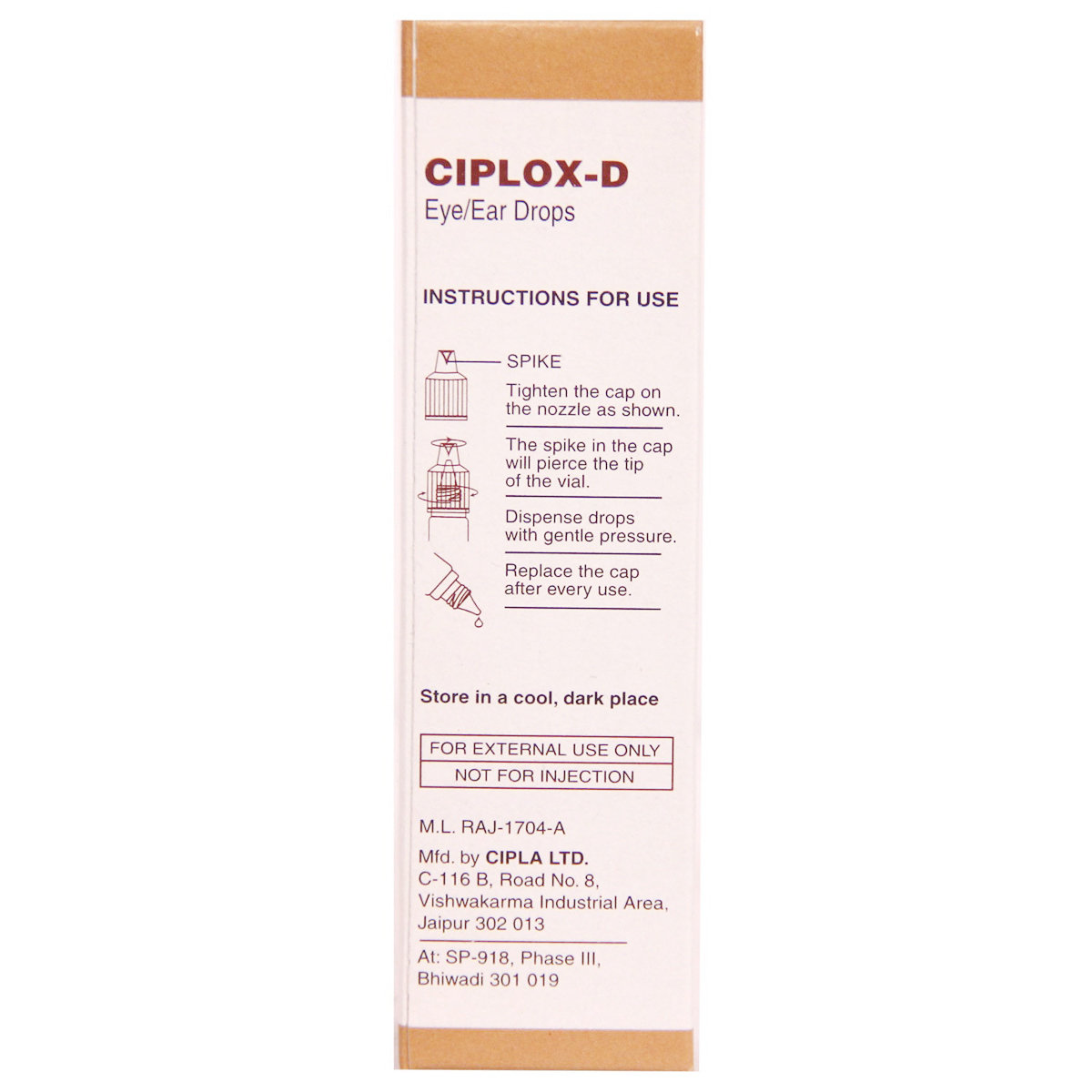
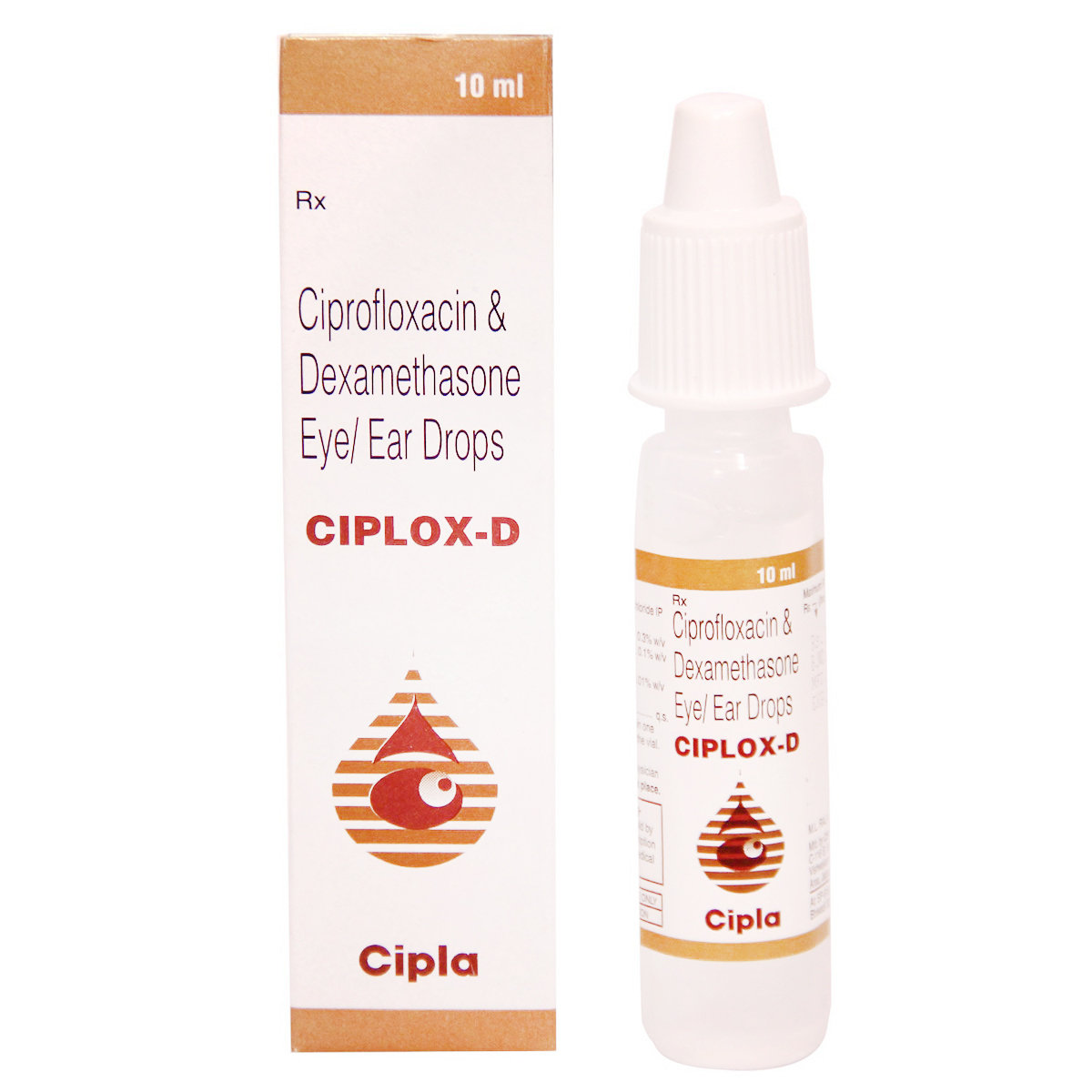
MRP ₹27
(Inclusive of all Taxes)
₹4.0 Cashback (15%)
know your delivery time
Provide Delivery Location
Manufacturer/Marketer :
Consume Type :
Expires on or after :
Return Policy :

Secure Payment

Trusted by 8 Crore Indians

Genuine Products
Therapeutic Class
Country of origin
Manufacturer/Marketer address
Author Details
We provide you with authentic, trustworthy and relevant information
Disclaimer
Alcohol
Safe if prescribed
It is not known whether Ciplox-D Eye/Ear Drops interacts with alcohol. Please consult your doctor.
Pregnancy
Consult your doctor
Please consult your doctor if you have any concerns regarding this; your doctor will prescribe only if the benefits outweigh the risks.
Breast Feeding
Consult your doctor
Please consult your doctor if you have any concerns regarding this; your doctor will decide whether Ciplox-D Eye/Ear Drops can be used by breastfeeding mothers or not.
Driving
Safe if prescribed
Ciplox-D Eye/Ear Drops may temporarily blur your vision when instilled in the eyes. So, avoid driving or operating machinery until your vision is clear.
Liver
Consult your doctor
Please consult your doctor if you have any concerns regarding the usage of Ciplox-D Eye/Ear Drops in patients with liver impairment.
Kidney
Consult your doctor
Please consult your doctor if you have any concerns regarding the usage of Ciplox-D Eye/Ear Drops in patients with kidney impairment.
Children
Safe if prescribed
Ciplox-D Eye/Ear Drops should be used in children only if prescribed by the doctor.
About Ciplox-D Eye/Ear Drops
Ciplox-D Eye/Ear Drops is a combination medicine used to treat bacterial eye infections, post-operative inflammatory conditions of the eyes, acute otitis media (middle ear infections) and acute otitis externa (inflammation of the ear canal). Bacterial eye infection is associated with the inflammation or infection of the conjunctiva (white part of the eye) and the inner eyelid. An ear infection occurs when the bacteria affect the middle or outer ear, leading to pain and inflammation.
Ciplox-D Eye/Ear Drops is a combination of three drugs, namely: Ciprofloxacin, Dexamethasone, and Benzalkonium chloride. Ciprofloxacin kills the infection-causing bacteria by inhibiting the synthesis of enzymes necessary for the survival of bacteria. Dexamethasone blocks the chemical messengers that cause swelling, itching, and redness. Benzalkonium chloride acts as a preservative. Thereby, Ciplox-D Eye/Ear Drops helps in treating bacterial infections of the eye and ear.
You are advised to use Ciplox-D Eye/Ear Drops for as long as your doctor has prescribed it for you, depending on your medical condition. In some cases, Ciplox-D Eye/Ear Drops may cause common side-effects such as discomfort, irritation, stinging sensation, and redness. Most of these side-effects do not require medical attention and will resolve gradually over time. However, you are advised to talk to your doctor if the side-effects persist or worsen.
Talk to your doctor if the irritation persists despite using Ciplox-D Eye/Ear Drops for a week or if it worsens. Consult your doctor if you are pregnant or breastfeeding. Ciplox-D Eye/Ear Drops should be used in children only if prescribed by the doctor. Do not touch the tip of the dropper, as it may contaminate the contents. Keep your doctor informed regarding your health condition and the medicines you are taking to prevent any side-effects/interactions.
Uses of Ciplox-D Eye/Ear Drops
Medicinal Benefits Mweb
Key Benefits
Ciplox-D Eye/Ear Drops is a combination of three drugs, namely: Ciprofloxacin, Dexamethasone, and Benzalkonium chloride. Ciplox-D Eye/Ear Drops is used to treat bacterial eye infections, post-operative inflammatory conditions of the eyes, acute otitis media (middle ear infections) and acute otitis externa (inflammation of the ear canal). Dexamethasone is a corticosteroid that blocks the chemical messengers that cause swelling, itching, and redness. Ciprofloxacin is an anti-bacterial agent which kills the bacteria by preventing the synthesis of essential proteins required for the survival of the bacteria. Benzalkonium chloride acts as a preservative. Together, Ciplox-D Eye/Ear Drops helps in treating bacterial infections of the eye/ear.
Directions for Use
Side Effects of Ciplox-D Eye/Ear Drops
- Discomfort
- Irritation
- Stinging sensation
- Redness
Drug Warnings
Do not use Ciplox-D Eye/Ear Drops if you are allergic to any of its contents. Avoid using Ciplox-D Eye/Ear Drops if you have tuberculosis, damaged cornea, ulceration, lesions with incomplete formation of the covering tissue, increased intraocular pressure, allergy to steroids, viral ear infections, herpes simplex, fungal or parasitic ear infection. Inform your doctor if you have high closed-angle glaucoma, high blood pressure, ocular hypertension, diabetes, eye infection or injury, hyperthyroidism, heart, kidney or liver problems. Consult your doctor if you are pregnant or breastfeeding. Ciplox-D Eye/Ear Drops should be used in children only if prescribed by the doctor.
Drug-Drug Interactions
Drug-Drug Interactions
Login/Sign Up
When Dronedarone is taken with Ciplox-D Eye/Ear Drops 10 ml, it can increase the chance of a serious abnormal heart rhythm. If you suffer from any cardiac conditions, or electrolyte disturbances (such as magnesium or potassium deficiency brought on by severe or prolonged diarrhea or vomiting), you may be at higher risk.
How to manage the interaction:
Taking Ciplox-D Eye/Ear Drops 10 ml with Dronedarone is not recommended, it can be taken if prescribed by the doctor. However, if you experience sudden dizziness, lightheadedness, fainting, breathing difficulty, or rapid heartbeat, consult the doctor immediately. Do not stop any medications without a doctor's advice.
When Ciplox-D Eye/Ear Drops 10 ml is taken with Quinidine, it can increase the chance of a serious abnormal heart rhythm.
How to manage the interaction:
Taking Ciplox-D Eye/Ear Drops 10 ml with Quinidine is not recommended, it can be taken if prescribed by the doctor. However, if you experience sudden dizziness, lightheadedness, fainting, breathing difficulty, or rapid heartbeat, consult the doctor immediately. Do not stop any medications without a doctor's advice.
When Flibanserin is taken with Ciplox-D Eye/Ear Drops 10 ml, it can cause extreme drowsiness and reduces blood pressure that can lead to dizziness, lightheadedness, fainting.
How to manage the interaction:
Taking Ciplox-D Eye/Ear Drops 10 ml with Flibanserin is not recommended, but it can be taken if prescribed by the doctor. It is advised to take flibanserin at bedtime to reduce the risk of side effects
When Ciplox-D Eye/Ear Drops 10 ml is taken with Pimozide, it can increase the chance of a serious abnormal heart rhythm. If you suffer from any cardiac conditions, or electrolyte disturbances (such as magnesium or potassium deficiency brought on by severe or prolonged diarrhea or vomiting), you may be at higher risk.
How to manage the interaction:
Taking Ciplox-D Eye/Ear Drops 10 ml with Pimozide is not recommended, it can be taken if prescribed by the doctor. However, if you experience sudden dizziness, lightheadedness, fainting, breathing difficulty, or rapid heartbeat, consult the doctor immediately. Do not stop any medications without a doctor's advice.
Combining Ciplox-D Eye/Ear Drops 10 ml with Thioridazine can increase the chance of a serious abnormal heart rhythm. If you suffer from any cardiac conditions, or electrolyte disturbances (such as magnesium or potassium deficiency brought on by severe or prolonged diarrhea or vomiting), you may be at higher risk.
How to manage the interaction:
Taking Ciplox-D Eye/Ear Drops 10 ml with Thioridazine is not recommended, it can be taken if prescribed by the doctor. However, if you experience sudden dizziness, lightheadedness, fainting, breathing difficulty, or rapid heartbeat, consult the doctor immediately. Do not stop any medications without a doctor's advice.
Coadministration of sotalol together with Ciplox-D Eye/Ear Drops 10 ml can increase the risk or severity of irregular heart rhythm.
How to manage the interaction:
Taking Sotalol with Ciplox-D Eye/Ear Drops 10 ml is generally avoided as it can result in an interaction, it can be taken together if prescribed by a doctor. However, consult the doctor if you experience sudden dizziness, lightheadedness, fainting, breathing difficulty. Do not discontinue any medications without consulting a doctor.
Using Ciplox-D Eye/Ear Drops 10 ml with Procainamide can increase the chance of a serious abnormal heart rhythm.
How to manage the interaction:
Taking Ciplox-D Eye/Ear Drops 10 ml with Procainamide is not recommended, it can be taken if prescribed by the doctor. However, if you experience sudden dizziness, lightheadedness, fainting, breathing difficulty, or rapid heartbeat, consult the doctor immediately. Do not stop any medications without a doctor's advice.
Using Ciplox-D Eye/Ear Drops 10 ml with Cisapride can increase the chance of a serious abnormal heart rhythm. If you suffer from any cardiac conditions, or electrolyte disturbances (such as magnesium or potassium deficiency brought on by severe or prolonged diarrhea or vomiting), you may be at higher risk.
How to manage the interaction:
Taking Ciplox-D Eye/Ear Drops 10 ml with Cisapride is not recommended, it can be take if prescribed by the doctor. However, if you experience sudden dizziness, lightheadedness, fainting, breathing difficulty, or rapid heartbeat, consult the doctor immediately. Do not stop any medications without a doctor's advice.
Coadministration of Ciplox-D Eye/Ear Drops 10 ml and Tizanidine together can increase the risk of side effects.
How to manage the interaction:
Using Ciplox-D Eye/Ear Drops 10 ml and Tizanidine together is avoided, as it can result in an interaction, it can be taken if your doctor has advised it. However, if you experience drowsiness, weakness, sweating, or palpitations contact the doctor immediately. Do not discontinue any medications without consulting the doctor.
Taking Amiodarone and Ciplox-D Eye/Ear Drops 10 ml may significantly increase the risk of an abnormal heart rhythm.
How to manage the interaction:
Taking Amiodarone with Ciplox-D Eye/Ear Drops 10 ml is not recommended, it can be taken together if prescribed by a doctor. However, consult your doctor if you experience sudden dizziness, lightheadedness, fainting, shortness of breath. Do not discontinue any medications without consulting a doctor.
Drug-Food Interactions
Drug-Food Interactions
Login/Sign Up
Tofu Set With Calcium, Ragi, Seasame Seeds, Kale, Milk, Almonds, Bok Choy, Calcium-Fortified Soy Milk, Cheese, Yogurt, Cocoa, Coffee, Dark Chocolate, Energy Drinks With Caffeine, Green Tea, Kola Nut, Tea, Tiramisu
How to manage the interaction:
Using caffeine together with ciprofloxacin may increase the effects of caffeine. Taking dairy products such as milk, yogurt, or calcium-fortified foods can make the medication less effective. Avoid taking caffeine with ciprofloxacin, as it causes effects. Contact your doctor if you experience headaches, tremors, restlessness, nervousness, insomnia, and increased blood pressure or heart rate. Avoid taking milk, yogurt, or calcium-fortified foods. You could interrupt the feeding for 1 hour before and 2 hours after the ciprofloxacin dose. Do not stop using any medications without talking to your doctor.
Drug-Diseases Interactions
Drug-Diseases Interactions
Login/Sign Up
Drug-Drug Interactions Checker List
- RITONAVIR
- COBICISTAT
Habit Forming
Diet & Lifestyle Advise
Eye infections:
- Wash your hands regularly. Avoid touching the eyes with dirty hands.
- Avoid rubbing the eyes.
- Avoid sharing eye makeup such as eyeliner, mascara or kohl.
- Always use clean towels or tissues to wipe your eyes and face.
- Regularly wash and change the pillowcases.
- If you wear contact lens: Clean and replace contact lens more often. Never share contact lens. Always remember to wash your hands before inserting and after removing the contact lens.
- Avoid staring at digital screens for longer durations. Rest your eyes for every 20 minutes.
- Blink regularly as it helps in the spread of hydrating substances such as mucus and tears across the eyes.
Ear infections:
- Include fruits, vegetables, high-quality proteins and whole wheat grains in your diet to strengthen the immune system.
- Avoid consuming foods that you are allergic to as it can cause the body to produce excess mucus leading to inflammation.
- Avoid getting things like shampoo, soap, and water into the ear, as it can cause itching.
- Do not poke or scratch the ear, as it can cause damage to the ear canal, leading to inflammation. The inflamed skin can be infected by bacteria or fungi, which can cause infections in the ear.
- Stay healthy as immunity prevents infections.

Have a query?
Buy best Ocular products by
Entod Pharmaceuticals Ltd
Ajanta Pharma Ltd
Sunways (India) Pvt Ltd
Sun Pharmaceutical Industries Ltd
Cipla Ltd
Micro Labs Ltd
Allergan Healthcare India Pvt Ltd
Intas Pharmaceuticals Ltd
Raymed Pharmaceuticals Ltd
Nri Vision Care India Ltd
FDC Ltd
Jawa Pharmaceuticals India Pvt Ltd
Indoco Remedies Ltd
Sapient Laboratories Pvt Ltd
Senses Pharmaceuticals Pvt Ltd
Centaur Pharmaceuticals Pvt Ltd
Neomedix Healthcare India Pvt Ltd
Aromed Pharmaceuticals
Optho Remedies Pvt Ltd
Aurolab
Austrak Pvt Ltd
Lupin Ltd
Mankind Pharma Pvt Ltd
Zivira Labs Pvt Ltd
Optho Pharma Pvt Ltd
Synovia Life Sciences Pvt Ltd
Akumentis Healthcare Ltd
Eyekare
His Eyeness Ophthalmics Pvt Ltd
Protech Remedies Pvt Ltd
Runyon Pharmaceutical Pvt Ltd
Alcon Laboratories Inc
Syntho Pharmaceuticals Pvt Ltd
Alembic Pharmaceuticals Ltd
Bell Pharma Pvt Ltd
Klar Sehen Pvt Ltd
Sentiss Pharma Pvt Ltd
Irx Pharmaceuticals Pvt Ltd
Optho Life Sciences Pvt Ltd
Phoenix Remedies Pvt Ltd
Alkem Laboratories Ltd
Doctor Wonder Pvt Ltd
Hicare Pharma
Ipca Laboratories Ltd
Neon Laboratories Ltd
Okulus Drugs India
Pharmtak Ophthalmics (I) Pvt Ltd
Berry & Herbs Pharma Pvt Ltd
Glow Vision Pharmaceuticals
Kaizen Drugs Pvt Ltd
Choroid Laboratories Pvt Ltd
Indiana Opthalamics Pvt Ltd
Optica Pharmaceutical Pvt Ltd
Pharmatak Opthalmics India Pvt Ltd
Samarth Life Sciences Pvt Ltd
Vibgyor Vision Care
Mofon Drugs
Novartis India Ltd
Pharmia Biogenesis Pvt Ltd
Zydus Cadila
Appasamy Ocular Devices Pvt Ltd
Leeford Healthcare Ltd
Medivision Pharma Pvt Ltd
Orbit Life Science Pvt Ltd
X-Med Royal Pharma Pvt Ltd
Zee Laboratories Ltd
Aarma Laboratories
Guerison MS Inc
Laborate Pharmaceuticals India Ltd
Xtas Pharmaceuticals
Accurex Biomedical Pvt Ltd
Blucrab Pharma Pvt Ltd
Does Health Systems Pvt Ltd
Flagship Biotech International Pvt Ltd
Lavue Pharmaceuticals Pvt Ltd
Nutrilis Healthcare Pvt Ltd
Ursa Pharm India Pvt Ltd
Vee Remedies
Vyonics Health Care India Pvt Ltd
Warren Pharmaceuticals Pvt Ltd
Abbott India Ltd
Accvus Pharmaceuticals
Akums Drugs & Pharmaceuticals Ltd
Cadila Healthcare Ltd
Carevision Pharmaceuticals Pvt Ltd
Dey's Medical Stores (Mfg) Ltd
East West Pharma India Pvt Ltd
Eyedea Pharmaceuticals Pvt Ltd
Nimbus Healthcare Pvt Ltd
Ocuris Pharmaceuticals Pvt Ltd
Sherings Pharmaceuticals
Tarks Pharmaceuticals Pvt Ltd
Vcan Biotech
Vision Medilink
Aice Health Care Pvt Ltd
Appasamy Pharmaceuticals Pvt Ltd
Asperia Lifescience Pvt Ltd
Beatum Healthcare Pvt Ltd
East India Pharmaceutical Works Ltd
Grevis Pharmaceutical Pvt Ltd
Customers Also Bought

_0.jpg?tr=q-85)


